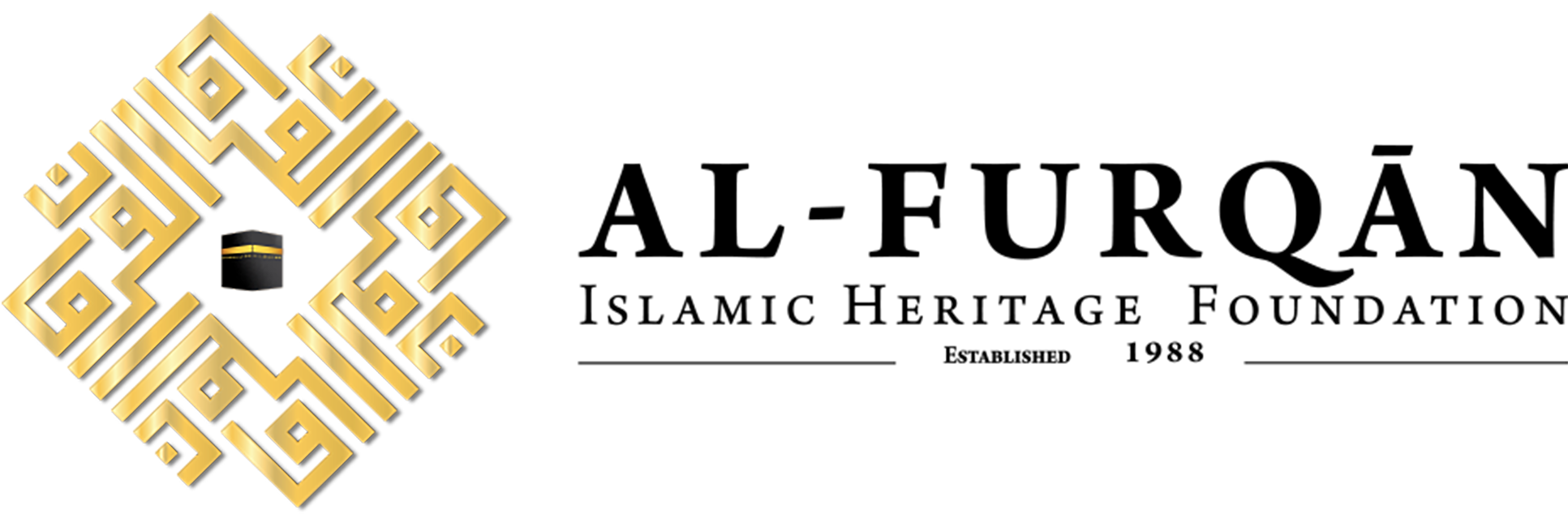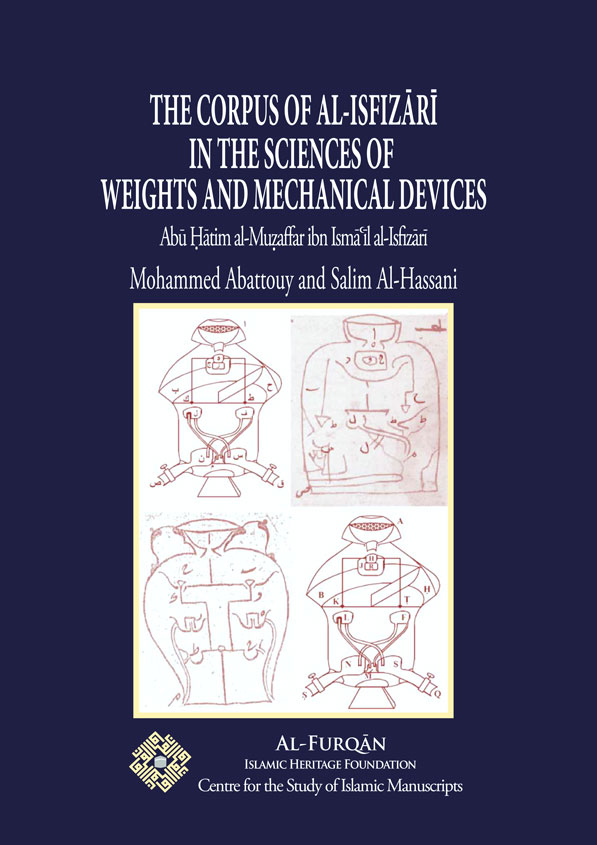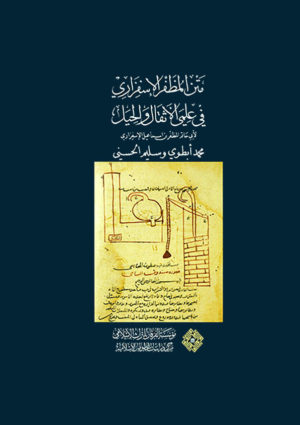In 2013, the Furqān Foundation published the critical edition of al-Isfizārī’s mechanical corpus prepared by Abattouy and Hassani (Matn al-MuÞaffar al-Isfizārī fī þilmay al-athqāl wa l-¬iyal. Ta¬qīq naqdī wa-dirāsa tārīkhiyya li-nu½ū½ jadīda fī taqlīd al-mīkānīkā al-þarabiyya). Now, this edition is complemented by an English translation and commentary of the texts related to the science of weights.
Something should be said, first of all, about the author (see pp. 31-49): Abū ©ātim al-MuÞaffar b. Ismāþīl al-Isfizārī (ca. 1048- ca. 1116) is a relatively unknown Iranian scientist who lived in the second half of the 11th and the beginning of the 12th century and was active in Isfahan and the area of Khurasan. Abattouy and Hassani have gathered some information about his life from the sources, two of which were written by authors who lived near al-Isfizārī’s own time: al-Bayhaqī’s (d. 1169-70) Tatimmat ½iwān al-¬ikma, and NiÞāmī þArūÅī Samarqandī’s (d. 1161) Chahār maqāla,.as well as Ibn al-Athīr’s (d. 1233) al-Kāmil fī l-tārīkh. Al-Isfizārī was a contemporary of þUmar al-Khayyām (1048-ca. 1123) with whom he worked at the Isfahan observatory founded by Malikshāh, which remained active between 1074 and 1092. In spite of this, and in spite of his interest in hay’a (astronomy or cosmology?), al-Isfizārī does not seem to have written any astronomical works, although he wrote books on theoretical and practical (misā¬a) geometry, meteorology, botany, natural science and mechanics, the last of which is the main focus of interest of this book.
Al-Isfizārī developed the two main branches of mechanics cultivated by Islamic scientists in the Middle Ages (pp. 13-29): þIlm al-athqāl (the science of weights) and þIlm al-¬iyal (the mechanics of machines). The former, which studies weights and their behaviour in balances, attracted the attention of Mohammed Abattouy some twenty years ago. Abattouy has focused on its development in Islamic lands, in which it was considered an independent discipline, between the 9th and the 19th centuries and has discovered fifty-eight treatises on the topic; he compiled a useful list of thirty-two of these treatises for the proceedings of the symposium A shared legacy. Islamic science East and West held in Barcelona in 2007 (published Barcelona, 2008, see pp. 92-99). The whole corpus contains translations from Greek sources (writings ascribed to Aristotle, Euclid, as well as authentic works by Archimedes, Heron and Pappus), original Arabic works written between the 9th and the 12th centuries beginning with Thābit ibn Qurra’s (d. 901) Kitāb fī l-qarasÐūn, and followed by practical texts dated between the 14th and the 19th centuries. The culminating point of this tradition is the Mīzān al-¬ikma of al-Khāzinī, probably a disciple of al-Isfizārī, which contained the description of an ideal balance able to measure absolute and specific weights, calculate exchange rates of currencies, and determine time. On the whole, as established by the authors of this volume, “the new Arabic science of weights was marked by a close combination of experimentation and mathematisation” (p. 26). Some of these works were translated into Latin – Gerard of Cremona, for example, translated Thābit’s qarasÐūn – and, thus, exerted an influence in the European science of weights which was born with Jordanus Nemorarius, in the 13th century.
Al-Isfizārī’s main contribution to the science of weights is to be found in the Irshād dhawī l-þirfān ilā ½ināþat al-qaffān (“Guiding people of knowledge in the art of the steelyard”). This book is dedicated to Abū Saþīd Mu¬ammad b. Man½ūr b. Mu¬ammad al-Isfizārī (d. 1101), identified by Abattouy and Hassani as one of Malikshāh’s officials (p. 34). Interestingly, both al-Isfizārī and his patron seem to have been natives of the city of Isfīzār, in Khurasan, and this might explain their association. This book has been preserved in a single incomplete manuscript (Damascus NL 4460) which contains the theoretical part of the book on the subjects of the centres of gravity, the law of the lever, and several causes of equilibrium. This text is translated into English (pp. 53-70) and analysed in detail by Abattouy and al-Hassani (pp. 89-109). The main sources used by al-Isfizārī are the Maqāla fī l-mīzān ascribed to Euclid and Thābit ibn Qurra’s Kitāb fī l-qarasÐūn; he faithfully reproduces the contents of the original texts and tries to improve them, probably with the purpose of making them more accessible for his students and easier to understand. As he says in the prologue (p. 55), his book contains “what I have learned from the sciences of the Ancients and their wise successors, in addition to my own thoughts and that which was deduced from demonstrations”. In fact, his methodology is clearly Euclidean: he begins with six axioms (mabādi’) related to centres of gravity – which do not need to be proved – and a series of examples which clarify the aforementioned principles (pp. 56-61). This is followed by a series of seven propositions or theorems, accompanied by the corresponding geometrical demonstrations. These propositions constitute al-Isfizārī’s analysis of the law of the lever, and the first six are reworkings of the corresponding ones in pseudo-Euclid’s Maqāla fī l-mīzān (pp. 61-68), while the seventh (pp. 68-70) derives from Thābit’s Kitāb fī l-qarasÐūn. Interestingly, in propositions 1-6 the beam of the balance is considered to be a line, with neither width nor weight, while in his analysis of proposition 7 al-Isfizārī clearly states that the beam is a heavy object.
The contents of the Damascus manuscript end here but, fortunately, the rest of al-Isfizārī’s book has been preserved in the second book of al-Khāzinī’s Mīzān al-¬ikma, in a passage entitled Fī marākiz al-athqāl wa-½anþat al-qaffān li l-MuÞaffar al-Isfizārī (“On the centres of gravity and the making of the steelyard by al-MuÞaffar al-Isfizārī”). This text, translated on pp. 71-87, is divided into four chapters of which the first two deal with the theoretical part of al-Isfizārī’s original work, without the geometrical demonstrations, while chapters 3 and 4 are purely practical. Chapter 3 describes how to make a steelyard, a balance with unequal arms, and how to weigh with it. Chapter 4, finally, deals with a set of common practical problems, such as converting a marked steelyard from one weighing system to another, since weights have different capacities in different geographical areas; calculating the complementary weight and subtracting it from the measured weight; replacement of lost parts and, finally, how to weigh when the weight of the load goes beyond the last mark on the steelyard.
The rest of the book is related to the þilm al-¬iyal (science of the mechanics of machines). Al-Isfizārī wrote a book without a title (which Abattouy and Hassani call Majmūþ fī l-¬iyal, codex of ¬iyal) preserved in two Arabic manuscripts (Osmania University Library in Hyderabad QC620/HJ and John Rylands Library in Manchester 351). In it he summarized the description of a collection of machines extracted from the following authors (in the order in which they appear in the text): the Banū Mūsā (9th c., pp. 113-191), Philon of Byzantium (ca. 280 BC - ca. 220 BC, pp. 193-230), Heron of Alexandria (1st c. AD, pp. 231-248), Apollonius of Perga (fl. ca. 262-190, pp. 271-275), and a brief text on the clock box (½undūq al-sāþāt) containing only two paragraphs which describe a kind of clock with automats. Interestingly, the second paragraph is a condensed description of a hydraulic organ known through the longer text of MūrisÐus (pp. 277-280).
The purpose of the codex of ¬iyal, as stated in the introduction, is to assemble “what has reached us from the books of the Ancients about different machines, and those who came after them until our era...We reproduced these devices in a concise style and with appropriate illustrations, as we found the previous copiers had misrepresented the illustrations and introduced many alterations in the letters representing the intent of the authors... We also pointed out their causes in some cases” (p. 113). The technique used by al-Isfizārī is that of the epitome, which involves rewriting the original text in a condensed form (see p. 45), as well as redrawing the faulty figures which have reached him in poorly copied manuscripts. This latter task has been repeated by Abattouy and Hassani who present the figures (which accompany their translation), both in a reconstructed modern form and in a reproduction of the ones that appear in the manuscripts.
The codex contains the whole set of the 100 devices described in the Banū Mūsā’s well-known Kitāb al-¬iyal (edited by A¬mad Yūsuf al-©asan and translated by Donald R. Hill) of which 73 are trick vessels for dispending liquids, 15 are automatic control systems, 7 water jets, 3 oil lamps, a bellows and a mechanical grab for excavating in the beds of streams. Philon of Byzantium’s original Pneumatics describes 78 mechanical constructions operated by hot air or steam but only 52 of them appear in al-Isfizārī’s collection. This is followed by a summary, with commentaries, of the first two books of Heron of Alexandria’s Mechanics, which deal with raising heavy objects, centres of gravity and an analysis of the five simple machines and their use, singly or in combination: axle (al-mi¬war), lever (al-mukhl), pulley (al-bakara), wedge (al-isfīn) and screw (al-lawlab). The most interesting part of the collection is, no doubt, the summary of Apollonius’ Kitāb al-bakara, a previously unknown work (not extant in Greek or in any translation) of the famous Greek mathematician author of the Conics. It contains a collection of seven demonstrated propositions with diagrams, five of which deal with the basic properties of cogwheels.
In the codex of ¬iyal, we obviously have an excellent collection of Greek sources on applied mechanics, of which the only important text missing is Pappus’ Mechanics, while the Islamic contribution is represented by the book of the Banū Mūsā. Al-Isfizārī’s work is a clear example of the assimilation and, in A.I. Sabra’s words, the “appropriation” of the Greek heritage, which was well understood by our author; he was able to summarize, comment upon and correct the faulty illustrations transmitted by the successive copies of the original source. Like the Irshād, the codex on ¬iyal seems to be a kind of handbook prepared by al-Isfizārī for the benefit of his students (pp. 32,109).
Abattouy and Hassani’s book is completed by an extremely useful Arabic-English glossary of technical terms, accompanied by commentaries (pp. 283-298), and by five appendices dealing with 1) a list of the manuscripts of the Irshād, the Mīzān al-¬ikma, and the Arabic books of the Banū Mūsā, Philon, Heron, Apollonius, the pseudo-Euclid and the short text on the ½undūq al-sāþāt (pp. 301-302); 2) a list of illustrations taken from the manuscripts (pp. 303-308); 3) four historical notes with information about the biobibliography of Philon, Heron, Apollonius and the Banū Mūsā (pp. 309-326); 4) tables of concordance between “the paragraphs, models or devices, and figures in the original texts of Banū Mūsā, Philon and Heron and their counterparts in the al-Isfizārī Codex of ©iyal” (pp. 327-334); and 5) sample pages of the manuscripts of al-Isfizārī and al-Khāzinī (pp. 335-383). The volume ends with a bibliography divided into a) Arabic primary and secondary sources and b) publications in other languages (pp. 385-395), and with an alphabetical index (pp. 397-399).
To sum up, the authors of this volume have made a great contribution to the history of theoretical and applied mechanics in the Islamic lands and provide a comprehensive study of a little known scientist of the second half of the 11th century. Their reconstruction and analysis of the contents of the Irshād can be considered exemplary and the only absence I can find is the lack of a commentary on the texts of the codex of ¬iyal, something acknowledged by the authors themselves in the title of the book to which they have added the subtitle “English translation, partial analysis and historical context”. This is, however, a very small defect in such an important book.







Reviews
There are no reviews yet.